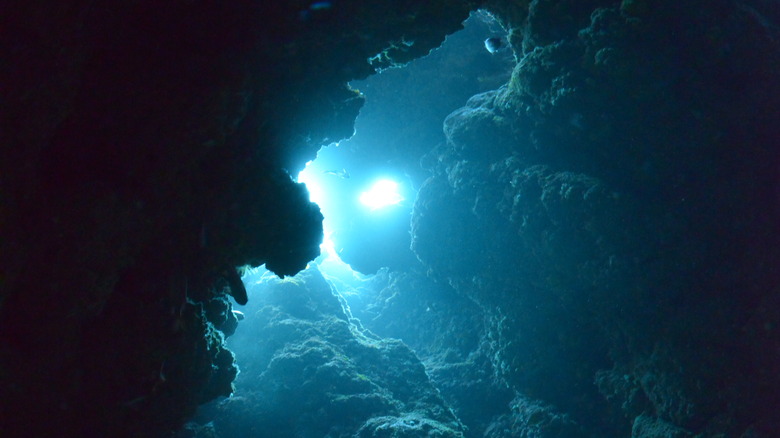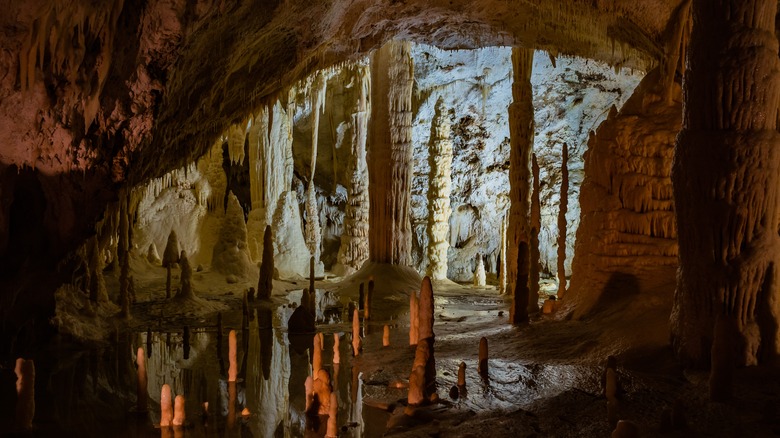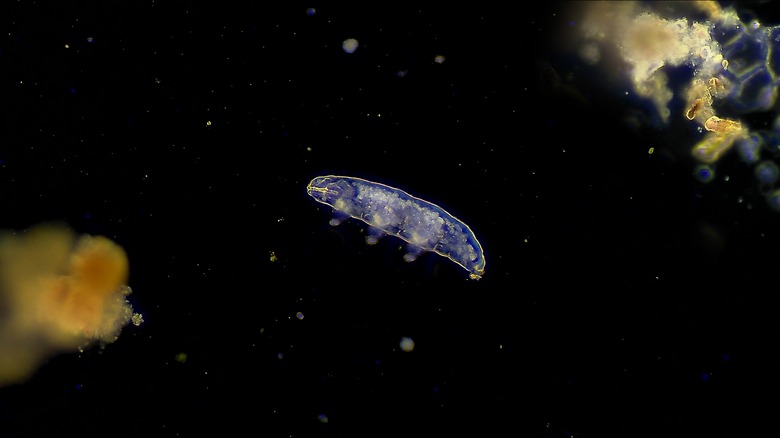Could Life Exist In Extraterrestrial Caves?
In 2017, Science News reported that giant crystals in the caves of Chihuahua, Mexico, were found to contain dormant microbes that had survived for 50,000 years. This discovery was a testament to the resiliency of microbial life. Moreover, it led to the question of how life in other inhospitable locales, specifically extraterrestrial ones, might fare. But it also underscored the fact that scientists don't know all there is to know about life in caves, making more exploration essential if we hope to one day understand the multitude of potential caves peppered throughout our corner of the cosmos.
This year, scientists made significant strides toward teasing out the secrets of the 3,545 possible caves identified in the solar system. Two new papers written by an international team of scientists led by Jut Wynne of Northern Arizona University produced questions about the extraterrestrial caves. Dozens of scientists from interdisciplinary fields put their heads together to advance this emerging field of planetary science and identify optimal ways to promote the quest for life in the subterranean parts of these bodies (per Science Daily).
What do scientists know about planetary caves?
Among the bodies in the solar system that have caves, there's Mars, the moons of Saturn, and Jupiter, Earth's moon, and even comets. According to the recent study published by the Journal of Geophysical Research, 20 years ago, the possibility of caves existing outside Earth was theoretical. But now, 11 bodies alone have yielded thousands of them, and (via JGR), "Six cave-forming processes beyond Earth have been identified ... " The study says that caves may be expected on any rocky or icy body, creating the possibility of microbial homes in disparate regions.
In 2019, maps revealed over 1,000 possible cave entrances on the red planet alone. Unfortunately, the spacecraft that identified them was 400 kilometers above the planet's surface, thus making it difficult to know their precise depths. The new study offers a map of all the known cave entrances, which includes those on Saturn's moons Titan and Enceladus, and Europa — the icy moon of Jupiter that may contain an ocean. Even our moon holds some spelunking potential (via CNET). But the red planet's Earth-like qualities still stand out among the candidates to harbor life.
Digging for life on Mars
Discoveries on Mars include sinuous channels suggesting that liquid water once flowed on the planet (per Physics.org). In addition, according to a study published on Nature, Mars once had a "warmer, wetter" climate, much like Earth's, which further implies the possibility that life once proliferated there. Indeed, Rovers like Curiosity and Opportunity were designed in part to investigate it.
It seems like a science fiction plot, but among the caves on Mars, we can picture rugged microbes that remained protected from radiation levels on the surface and were allowed to live for millennia. An earthly example of this came in a 1996 study published in Science which described the discovery of aquatic and terrestrial species in Movile Cave in Romania — a cave that had been sealed off since prehistoric times but retained endemic life forms in that ecosystem. The 1996 study and many others highlight that even Earth's life can have longevity in sunless, freezing environments.
Life at its most extreme
The critters that crawl and swim through the dark depths of caves are often called "extremophiles." These creatures earned their moniker for being able to withstand, and even thrive, in extreme environments, including the interiors of rock or minerals, and low-moisture or high-pressure environments (per Britannica). The ones found in caves can often withstand conditions devoid of sunlight and airflow as the atmosphere maintains a temperature similar to the terrestrial surface, per Science Daily. Scientist Jut Wynne said, "The caves of other planetary bodies likely exhibit similar environmental conditions, but these will also be influenced by the surface conditions of the planetary body and the internal structure of the cave."
Mars' average surface temperature is extremely low. At -81 degrees Fahrenheit (per the National Weather Service), the red planet's caves are likely quite frigid. However, some areas of the lower latitudes of Mars can run as high as 70 degrees Fahrenheit during the summer. Similarly, Titan and Enceladus are frigid at around -300 degrees Fahrenheit for both bodies (per NASA). However, could life find a way?
Conan the Bacterium
One of the hardiest bacteria on the planet, Deinococcus radiodurans, also called "Conan the Bacterium," was discovered by researchers at the Uniformed Services University of the Health Sciences in Maryland. Michael Daly, the pathologist who led the team, found Conan duly suited for Earth and the Martian terrain. The formidable little bacterium managed to muddle through radiation exposures that would extinguish any other organism. The study, conducted this year, found that if Conan lived 33 feet under the surface of Mars, it could survive dry and frozen conditions for up to 280,000,000 years (via Space.com).
During the study, multiple microbes were tested in temperatures as low as -80 F, with no other microbe pulling through with Conan's fortitude, per Space.com. Although conditions get even more extreme when looking at Titan and Enceladus, Conan gives us a glint of hope. A note of optimism comes inadvertently from the National Park Service. They tell us that caves differ from the irregular surfaces of planets because they maintain constant conditions, potentially meaning fewer challenges over time for microbes like Conan.
Preparing for space-age spelunking
According to the study "Planetary Caves: A Solar System View of Processes and Products" led by Jut Wynne, attaining and analyzing high-resolution imagery is important in the identification of new caves in the solar system. The authors anticipate more confirmed caves in the future with increased mapping attempts. Indeed, the study extends beyond moons and planets to include comets, which also have speleogenic qualities (a term referring to the process of cave formation); thus, they believe future missions should focus on their pits and fractures so imagery and identification can improve (via JGR).
Studies probing the caverns of outer solar system bodies — like Titan and Europa — will prove challenging, but they believe drone and Rover missions will provide needed data. For bodies nearer to Earth, like the moon and Mars, studies prophesize that we'll see robotic missions within the next two decades, per JGR. In the meantime, we can watch this chapter of space exploration unfold with anticipation, as it may be the path that proves we are not the only life in the solar system.





